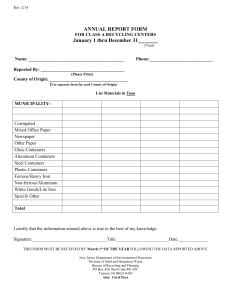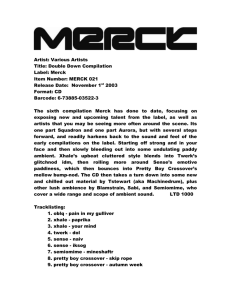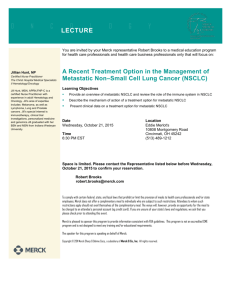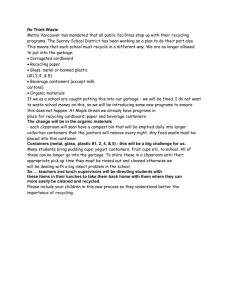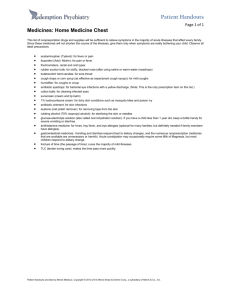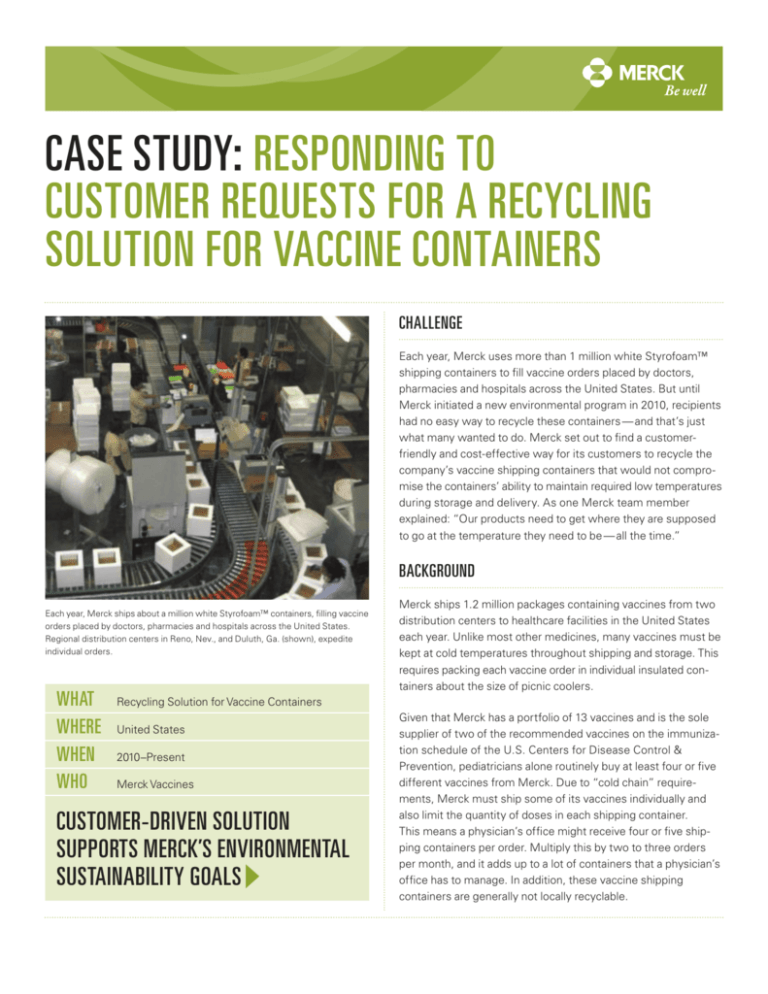
caSe Study: reSponding to
cuStomer reQueStS for a recycling
Solution for vaccine containerS
challenge
Each year, Merck uses more than 1 million white Styrofoam™
shipping containers to fill vaccine orders placed by doctors,
pharmacies and hospitals across the United States. But until
Merck initiated a new environmental program in 2010, recipients
had no easy way to recycle these containers — and that’s just
what many wanted to do. Merck set out to find a customerfriendly and cost-effective way for its customers to recycle the
company’s vaccine shipping containers that would not compromise the containers’ ability to maintain required low temperatures
during storage and delivery. As one Merck team member
explained: “Our products need to get where they are supposed
to go at the temperature they need to be — all the time.”
BacKground
Each year, Merck ships about a million white Styrofoam™ containers, filling vaccine
orders placed by doctors, pharmacies and hospitals across the United States.
Regional distribution centers in Reno, Nev., and Duluth, Ga. (shown), expedite
individual orders.
what
where
when
who
Merck ships 1.2 million packages containing vaccines from two
distribution centers to healthcare facilities in the United States
each year. Unlike most other medicines, many vaccines must be
kept at cold temperatures throughout shipping and storage. This
requires packing each vaccine order in individual insulated containers about the size of picnic coolers.
Recycling Solution for Vaccine Containers
United States
2010–Present
Merck Vaccines
cuStomer-driven Solution
SupportS mercK’S environmental
SuStainaBility goalS
Given that Merck has a portfolio of 13 vaccines and is the sole
supplier of two of the recommended vaccines on the immunization schedule of the U.S. Centers for Disease Control &
Prevention, pediatricians alone routinely buy at least four or five
different vaccines from Merck. Due to “cold chain” requirements, Merck must ship some of its vaccines individually and
also limit the quantity of doses in each shipping container.
This means a physician’s office might receive four or five shipping containers per order. Multiply this by two to three orders
per month, and it adds up to a lot of containers that a physician’s
office has to manage. In addition, these vaccine shipping
containers are generally not locally recyclable.
“We definitely heard the strong voice
of customers telling us that it was
important to them to find a way to
recycle these containers.”
Lois Burkey, Merck Vaccines team, West Point, Pennsylvania
Solution: facilitating customerfriendly, cost-effective recycling
of empty shipping containers
In 2008, Merck launched its new Commercial Model, an initiative that places customers at the center of our work. Customers
had been demanding more from companies and new types of
relationships, requiring Merck to change how it marketed and
sold its medicines and vaccines. As part of this new approach,
Merck’s Vaccine Division (MVD) created a Customer Feedback &
Response team tasked with speaking with customers to understand their needs, challenges and desires related to how we
conducted business with them, and integrating their findings
throughout Merck decision-making.
One resounding customer comment was that receiving and then
having to discard so many vaccine containers was a nuisance.
Some healthcare facilities, particularly in the Northwest, actually
went to the trouble of seeking out local recycling centers and
taking them there themselves. It was clear that today’s customers expected Merck to be environmentally responsible and to
help its customers be so as well.
Joined by colleagues from Merck’s Global Procurement group,
the MVD Feedback & Response team faced many questions:
• How many customers would use a recycling program?
• How much would it cost?
• C
ould Merck sustain the cost of the program, especially
if participation continued to grow?
• W
ould the containers be returned contaminated with
used needles, empty vaccine vials, or other waste?
The team knew it wanted to create a process similar to that of
recycling printer cartridges. And, of course, the process had to
be very easy for customers.
In 2009, the team began a five-state pilot program. Here’s how
it worked: A physician’s office, pharmacy or hospital ordered
vaccines directly from Merck. Merck shipped the vaccines in
their special containers. Each container included instructions on
how to recycle the container (e.g., empty the container before
shipping) printed on an adhesive material that served as packing
tape to seal the container upon returning it. Also included was a
prepaid UPS shipping label. The containers were picked up by
UPS and sent to one of two Merck-identified recycling facilities.
The recycling facilities then turned the Styrofoam containers into
other materials such as insulation and building materials.
About 30 percent of the customers included in the pilot program
participated, with nearly no instances of needles or other refuse
being left inside the returned containers. The MVD team presented its results to management, estimating an annual program
cost of $2 million based on an uptake of 30 to 40 percent.
The team delivered its findings to MVD management. The
response from then-MVD President Margie McGlynn: If this is
what our customers want, then we will figure out how to
develop a national recycling program and what it would cost.
Individual orders — and proper coolants — are packed into insulated containers.
Unlike many other medicines, vaccines must be kept at cold temperatures
throughout shipping and storage.
The initiative was approved. “There wasn’t a lot of discussion or
challenge,” remembered Craig Kemp, Senior Director, Customer
Value, Merck Vaccines. “Senior management knew this was the
right thing to do, and they did it. It made me really proud to work
for the Company.”
In February 2010, Merck rolled out the container recycling program to its entire western U.S. territory. In late May 2010, the
eastern half of the country was added. By June, fully 20 percent
of the insulated Merck containers were being returned to
recycling facilities in Michigan and California. Today that number
stands at 40 percent (~20,000 containers), which prevents
40,000 lbs. of Styrofoam from being added to landfills or burned
in incinerators each year — an admirable result for a voluntary
recycling program in little more than one year’s time.
“We did this not only because it was
the right thing to do, but [also because]
it’s what our customers wanted. People
want to do business with a company
that is socially responsible.”
Craig Kemp, Senior Director, Customer Feedback & Response,
Merck Vaccines
“This program is responding to a customer demand. And it’s
helping to build trust and value with our customers,” says Kemp.
“We are doing more than selling a product; this program tells
our customers that Merck is part of their community and takes
its responsibility to the environment seriously.”
During a field visit to Arkansas just after the national launch
of the program, a Merck Field Sales Customer Team Leader
heard positive feedback from healthcare providers and staff.
“Customers stated multiple times that they are very happy
about Merck deciding to recycle.”
The recycling program is also important to many Merck
employees, who believe that companies have a responsibility
for environmental sustainability and want to work for a company
that demonstrates its commitment through action.
Such customer and employee satisfaction benefits, while
difficult to quantify, are critical to the program’s sustainability,
particularly given that the recycling program accounts for almost
10 percent of Merck’s annual vaccine shipping budget.
Another important factor is that the program supports Merck’s
corporate packaging goal, announced in 2011, which aims for
50 percent of Merck’s revenue to be derived by 2020 from the
sale of products that have at least one sustainable-packaging
attribute, such as attachment to a packaging take-back program.
what’s next?
Kemp and his team are now working with the Merck Packaging
Technology team and Merck’s vaccine shipping-container
manufacturer to create a vaccine shipping container using
recycled polystyrene. The containers, which need to be tested
to ensure that they perform to the same standard as the existing
containers and meet all regulatory requirements without a
significant increase in price, would, if successful, increase the
environmental benefits of Merck’s vaccine shipping-container
recycling program.
Another option Merck is exploring is making its containers
reusable. In this model, customers would send the shipping
containers back to a third party, who would then clean, test,
and return the containers to Merck to reuse in shipping vaccines
to other customers. Currently, the cost of making containers
reusable is significantly higher than that of recycling Styrofoam
containers, but Kemp believes it would pay for itself in time.
The challenge is setting up an innovative logistics system to
make it work, he says.
Merck is also looking at expanding the current recycling
program into other countries and to other products with cold
chain requirements.
“There has been very little — if any — innovation in medical
logistics; we’ve been shipping products the same way for
decades,” says Kemp. “Other industries have innovated and
created more efficiency in the process — we can now get fresh
fruit from South America in the winter, for example. This was
innovation. Now it’s our turn. This makes sense for our business
and for our customers.”
To learn more about Merck’s environmental
sustainability journey, click here.
Copyright © 2011 Merck Sharp & Dohme Corp., a subsidiary of Merck & Co., Inc. All rights reserved.

